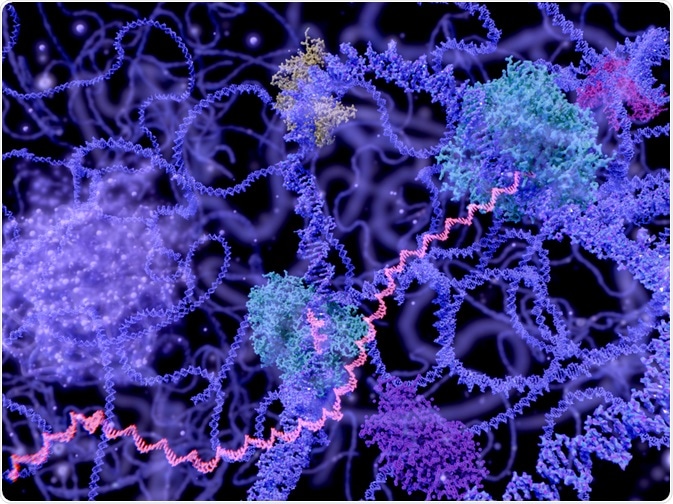Hereditary conditions cause those who suffer from them to live shorter lives with traumatic health issues. Because of this, researchers in the field of genetics are constantly exploring and developing gene therapies to cure them or alleviate the worst of their effects. This article will explore one such therapy which has showed real promise for inherited conditions, the process of exon skipping.
 Image Credit: Juan Gaertner/Shutterstock.com
Image Credit: Juan Gaertner/Shutterstock.com
What are exons?
All life is governed by genetics. In organisms that reproduce sexually, the parents pass down information in the form of genes to their offspring. Most of the time these genes code for healthy functions, but occasionally there are mutations that can cause an offspring to develop potentially fatal flaws in their genetic code.
Genes are divided into introns and exons. Exons code for specific proteins, whilst introns are non-coding (they are sometimes referred to as ‘junk DNA’) and are removed by RNA splicing. The remaining exons are then covalently bonded together to generate messenger RNA. The entire set of exons in a species constitutes the exome.
Unicellular eukaryotes such as yeast have very few or no introns, but complex multicellular organisms have many more in their genetic make-up. The Human genome contains 24% introns, 75% intergenic DNA, and only 1.1% exons. When there is a problem with the genes being spliced, complications can occur. One method which can be used to avoid errors in gene splicing is exon skipping.
Exon skipping – an overview
Exon skipping splices a gene and restores its reading frame. It encourages the cellular machinery to “skip” over an exon by masking it with antisense oligonucleotides (AONs), which are small pieces of synthesized DNA typically fifty base pairs long or less. They are alternatively known as molecular patches due to their use as a proverbial “sticking plaster”.
Exon skipping was first developed in the 1990s when scientists realized that they could make use of the body’s natural cellular splicing to downplay genetic mutations, turning them into less severe ones. Rather than remove the mutation, exon skipping merely allows the cellular mechanisms to ignore it when synthesizing new proteins. Thus, the disrupted reading frame is restored. The protein coded for is largely functional, even though it contains internal deletions.
Exon skipping as a treatment for Duchenne muscular dystrophy
Duchenne muscular dystrophy (DMD) is a condition that affects male offspring. In the UK, around 100 boys are born with it each year. The risk of a child being born with DMD is around 1 in 3,500 – 5,000.
DMD is a degenerative condition where the lack of a protein called dystrophin leads to muscle wasting. Muscle fibers break down over time, being replaced by fatty or fibrous tissue. Patients can become wheelchair-bound by their teenage years. The mutation which leads to the condition is generally an out-of-frame deletion mutation, which disrupts the cell’s ability to read the RNA beyond the point where the first error occurs. This causes a near-complete deficiency of full-length dystrophin.
Steroids can be used to strengthen the muscles, but as it is a degenerative disease, in time patients will still experience worsening symptoms. Exon skipping has been explored recently to manage the progression of symptoms by restoring the reading frame on the dystrophin gene. By using this method, the out-of-frame mutation is turned into an in-frame mutation.
By turning it into an in-frame mutation (similar to the mutation which causes the less severe Becker muscular dystrophy, or BMD) the reading frame is preserved and not disrupted, meaning that some dystrophin can still be produced. There are large repeating sections in the dystrophin protein, and the protein can still work to some extent with some of these sections missing. Patients with BMD show far less severe symptoms than those with DMD, often still able to walk into their 40s and 50s.
The genetic errors which cause DMD occur at different points along the gene which codes for the dystrophin protein. However, there are some areas where mutations commonly occur, such as exon 51. Skipping this exon would be beneficial for around 13% of patients. Skipping just one or two exons could treat around 83% of all DMD patients. It is hoped that cocktails of AONs that target different exons can be produced which can help a substantial proportion of patients in the future.
Prosensa's Video Animation on Exon Skipping
In conclusion
Exon skipping is a technology that is still in its infancy but is showing great promise as a therapeutic for DMD. Many different biotechnology companies are developing cocktails of exon skipping drugs and research into the technique could provide effective treatment for a number of other genetic conditions.
Sources
Muscular Dystrophy UK (Website) What is exon skipping and how does it work? [Accessed online 24th April 2021] www.musculardystrophyuk.org/.../
Aartsma-Rus, A & van Ommen, G-J (2007) Antisense-mediated exon skipping: A versatile tool with therapeutic and research applications RNA 13(10) pp. 1609-1624 [Accessed online 24th April 2021] https://www.ncbi.nlm.nih.gov/pmc/articles/PMC1986821/
Genome.gov (Website) Genetics Glossary – Exon [Accessed online 24th April 2021] https://www.genome.gov/genetics-glossary/Exon
Last Updated: May 7, 2021